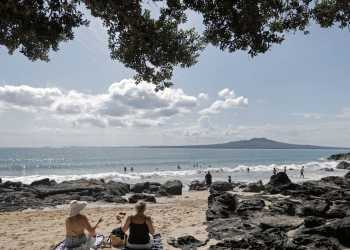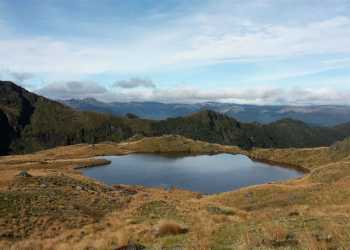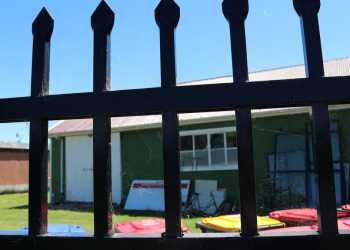Australia announces plan to double size of its navy
Last week, Australia’s Minister of Defence, Richard Marles announced plans to double the size of the nation’s navy over the next ten years. Australia’s navy currently has 11 surface warships and the fleet is planned to grow to 26, over the next decade. Concurrently, Australia will bring nuclear-powered submarines into service. Starting to operate American nuclear-powered submarines, on loan, within the next ten years followed by new AUKUS Class submarines in the mid-2030s.
Australia’s naval growth includes procuring six large Hunter class frigates, eleven general-purpose frigates, three air defence destroyers and six uncrewed surface warships. The programme also includes more Tomahawk cruise missiles to provide long-range precision-strike capabilities for both existing and new Australian ships.
People following defence trends in the Pacific will not be surprised by Australia’s decision to expand its surface fleet. The noteworthy points are the scale of the investment and the long-term integration of planning. This increase in both surface ships and submarines will make the Australian navy the largest it has been since World War Two. A fleet larger than at the height of the Cold War, a clear indication of how seriously Australia is taking the risk of Chinese aggression in the region.
Australia is looking far into the future, its investments linking with AUKUS to produce a more capable fleet. More surface ships that help deter Chinese aggression in the South China Sea and can police fishing and other marine resources. Nuclear-powered submarines able to operate aggressively against Chinese naval forces, in case of direct conflict.
Then there are technology programmes in the Second Pillar of AUKUS that link across the Australian military joining up programmes like the six un-crewed warships that will join the fleet, the MQ 28A Ghost Bat drone programme and the undersea communications programme we discussed two weeks ago.
Essentially, AUKUS provides long-term stability for joint development of military capabilities. Australia the US and UK working together to develop an interoperable and technologically superior force in the Pacific, and then integrating the work with other allies like Japan as required. The expansion of the Australian fleet is part of a wider defence strategy.
The key lesson for observers is that Australia has serious concerns about protecting its interests and is investing a significant amount of money to mitigate these concerns. An investment that it will expect allies and partners to match.
US foreign aid funding debate impacts in the Pacific
US lawmakers are currently caught at an impasse over the White House’s US$ 90 billion foreign aid Bill. Roughly two thirds of this package is ear-marked for Ukraine but hidden away within it is also funding for aid projects in the Pacific.
This week, Defence News reported that Pentagon officials are sounding alarm bells about the impact of Congress not passing the Bill. Pentagon officials are reported to be worried about the ‘Compact of Free Association,’ an arrangement the US has with Micronesian states; Palau, the Federated States of Micronesia and the Marshall Islands. In exchange for foreign aid these nations allow US forces free access to their strategically important territories and the ability to manage their air and sea space.

The islands are located south of Guam, a very important US base that is a ‘hub’ for operations in the west Pacific. Any US military operation, from supporting Japan or Korea, to helping allies around the South China Sea, defending Taiwan, or any potential operation in Melanesia is liable to be supported from Guam. If the security of the Micronesian states is compromised, Guam is at risk. Hence, the Pentagon’s concerns because if Palau, the Federated States of Micronesia and the Marshall Islands do not receive aid from the US they may be open to offers of aid from China, and may even allow Chinese military assets into their territories.
Officials are also concerned about the potential for the US to lose credibility in the wider Indo-Pacific region. If the US fails to meet its aid commitments, then Pacific nations may lose confidence and seek security relationships with China. A Chinese presence near Guam would be very unsettling for the US and the fact that this funding is being debated demonstrates the short-sightedness and insularity of American lawmakers. Winning a domestic political battle is a very temporary victory compared to the damage not funding the White House’s Bill would do to American strategy in the Pacific.
Antarctica, another area to watch
In February, China opened a new Antarctic research station, its fifth on the continent. The Qinling Station is located near the US McMurdo Base and New Zealand’s Scott Base, on the Ross Sea. The base is large with a staff of roughly 80 people in the summer and will be staffed year-round, expanding China’s presence in Antarctica.
Chinese activity in the Antarctic is increasing and the ABC reports that “China has ramped up krill fishing in the rich maritime ecosystem of Antarctica, worrying conservationists and scientists who are calling for stricter controls.” China’s large and capable fishing vessels can fish the Southern Oceans, and are not monitored as closely as in other more contested fishing grounds further north.
The 1959 Antarctic Treaty protects the continent’s resources including minerals, hydrocarbons and fresh water from exploitation. However, even if China’s current aims are peaceful, its activities indicate it is potentially manoeuvring to ensure long-term access to these resources. For instance, building new bases and producing large numbers of icebreakers specifically designed to operate in Antarctica that can support operations on the continent.

The Qinling Base has caused concern in Australia, where academics are warning of the potential security risks because of the base’s location. International news agency Reuters reporting that “Qinling was expected to include an observatory with a satellite ground station, and it would be well situated to collect signals intelligence over Australia and New Zealand, the Centre for Strategic and International Studies said in a report in April.”
Further, China has a history of non-compliance with Antarctic Treaty protocols. New Zealand academic, Professor Anne-Marie Brady identifying failures to report military personnel in Antarctica and highlighting the potential for bases on the continent to be used to jam or interfere with precision-guided weapons used by the US and its allies.

Looking at a map of Antarctica it is easy to see the reason that China’s bases on the continent could be useful for military purposes. Qinling Base is located near America’s McMurdo Station, that country’s largest base in Antarctica. Now it is open, it can potentially gather intelligence about American operations at McMurdo. In future Qinling’s location also provides a potential ‘signals’ listening base that covers an arc across the South Pacific. Professor Brady’s assessment that the bases could in future, be part of a network of ground stations gathering information or jamming and interfering with US and allied satellites or precision-guided weapons is a valid deduction.
The map also shows how Chinese bases are distributed across the continent, Qinling, Zhongshan and Great Wall are widely separated and between them could provide surveillance coverage of a large portion of the Southern Ocean, South Pacific and Southern Indian Ocean.
Significantly, Great Wall Station provides a potential surveillance location covering the Drake Passage and Zhongshan Station looks north into the Indian Ocean. Essentially, China has occupied key locations in Antarctica that could in future be used for military purposes like surveillance or even to base weapons able to attack shipping routes.
Adding weight to this assessment is China’s aggressive diplomacy in South America, especially loans and aid provided to the South American countries on the north side of the Drake Passage, Argentina and Chile. Argentina is China’s largest trading partner in South America and has received billions of dollars in aid and loans in recent years. China is now Chile’s largest trading partner; many Chinese ex-pats work in Chile and there is extensive private investment by Chinese companies. Late last year, Chinese President Xi Jin Ping visited Chile and complimented the country on establishing diplomatic relations with China.
China’s activity in Antarctica is currently peaceful, however it is important to remember that in the age of hybrid war competition for position and advantage is just as intense in peace as it is during conflict. Nations using soft power to gain advantages, like access to bases in strategic locations or intelligence that can be used during conflict. In Antarctica, China is building bases located in areas that may provide intelligence or be useful during a future conflict. Additionally, China is developing the logistic capacity to support operations in Antarctica by building ice-breakers and occupying areas like Qinling Station that have good air fields.
Activities that could provide the capability for an aggressive approach to protecting Chinese interests in Antarctica, or the Southern Ocean, an approach already being demonstrated in the South China Sea. Hopefully this will not happen, but the best way to avoid conflict developing is for all countries that support the international rule of law to actively monitor the situation and challenge any breech of the 1959 Antarctic Treaty. The aim being to be vigilant and prevent a situation like we see in the South China Sea developing on the frozen continent.
Melanesian update
A regular update on the Pacific’s least reported trouble spot; Melanesia.
Timor Leste disputes borders with Indonesia
Oecusse is a small Timor Leste enclave on the north side of Timor, surrounded by Indonesian territory. The area was the site of the first Portuguese settlement in Timor and is culturally connected to Timor Leste.
Most of the current border was set in 2005, after Timor Leste became independent, but there are still parts of the border being negotiated. Recently, the negotiation process created concern on the Oecusse border because local Timorese landowners feel they are losing land to Indonesia.
This issue is not violent and there is little likelihood of it escalating but it provides another example of a small territorial dispute in Melanesia that could become a larger issue.
Papua New Guinea’s Enga province is quiet this week
A large police and military response to inter-tribal fighting in Papua New Guinea’s Enga province means that this week violence has subsided. However, the situation is unlikely to remain peaceful. The area suffers from a cycle of killing and retribution that has a long history and local gunmen are sometimes able to match government forces.
Enga province and Papua New Guinea’s remote areas are worth watching. Activity here demonstrates how tenuous the rule of law can be in the Pacific. In the last couple of days, an Australian pilot and his crew were taken hostage and released after security forces intervention. In other parts of New Guinea like Manus Island piracy is reported, all contributing to the conclusion that some smaller nations may need military support from larger nations simply to maintain domestic security.
Papua New Guinea parliament still unstable
Papua New Guinean Prime Minister, James Marape continues to have a tough time in parliament since 12 MPs ‘crossed the floor’ two weeks ago. He now faces two ‘no confidence’ motions and is fighting hard to retain control of parliament.
This situation will take some time to culminate and is part of a wider trend in the Pacific of politicians using ‘no confidence’ motions to over turn governments. A dangerous trend, that undermines stability in some small Pacific nations.
Ben Morgan is a bored Gen Xer, a former Officer in NZDF and TDBs Military Blogger – his work is on substack










